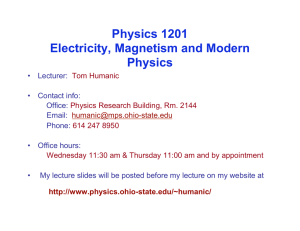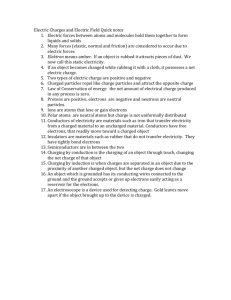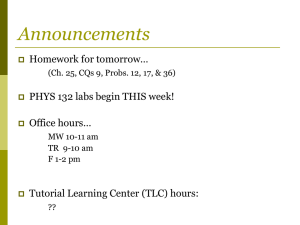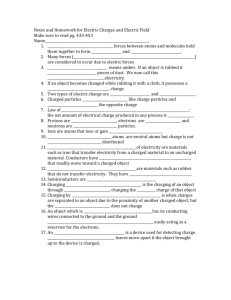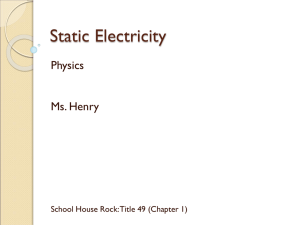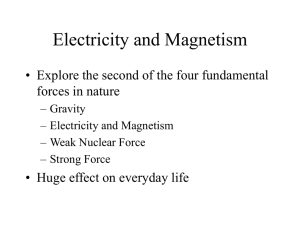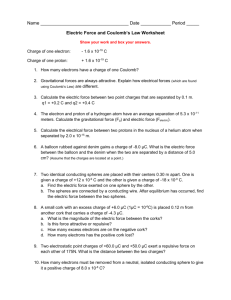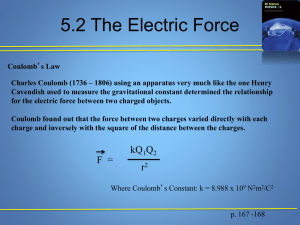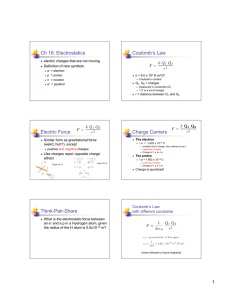Physics 112 Electricity and Magnetism
advertisement
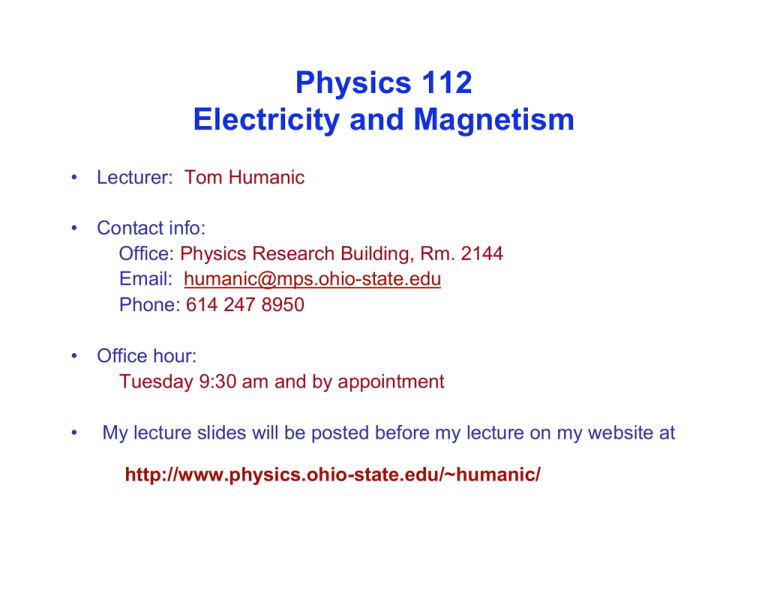
Physics 112 Electricity and Magnetism • Lecturer: Tom Humanic • Contact info: Office: Physics Research Building, Rm. 2144 Email: humanic@mps.ohio-state.edu Phone: 614 247 8950 • Office hour: Tuesday 9:30 am and by appointment • My lecture slides will be posted before my lecture on my website at http://www.physics.ohio-state.edu/~humanic/ Course Overview: Electricity & Magnetism • Electricity electric force electric field and potential electric currents, DC circuits and circuit devices • Magnetism magnetic force magnetic field • Electricity and Magnetism combined magnetic fields <---> electric currents electromagnetic waves --> light optics --> mirrors and lenses Chapter 18 Electric Forces and Electric Fields 18.1 The Origin of Electricity The electrical nature of matter is inherent in atomic structure. m p = 1.673 ×10 −27 kg mn = 1.675 ×10 −27 kg me = 9.11×10 −31 kg e = 1.60 ×10 −19 C Charge of electron and proton, smallest non-zero charge possible Coulomb -- SI unit of charge 18.1 The Origin of Electricity In nature, atoms are normally found with equal numbers of protons and electrons, so they are electrically neutral. By adding or removing electrons from matter it will acquire a net electric charge with magnitude equal to e times the number of electrons added or removed, N. q = Ne 18.1 The Origin of Electricity Example 1 A Lot of Electrons How many electrons are there in one coulomb of negative charge? q = Ne q 1.00 C 18 N= = = 6.25 ×10 -19 e 1.60 ×10 C a lot! 18.2 Charged Objects and the Electric Force (ebonite is hard rubber) It is possible to transfer electric charge from one object to another by moving around electrons, which move easier than positive charges. The body that loses electrons has an excess of positive charge, while the body that gains electrons has an excess of negative charge. 18.2 Charged Objects and the Electric Force LAW OF CONSERVATION OF ELECTRIC CHARGE During any process, the net electric charge of an isolated system Remains constant (is conserved). 18.2 Charged Objects and the Electric Force Like charges repel and unlike charges attract each other. 18.3 Conductors and Insulators Not only can electric charge exist on an object, but it can also move through an object. Substances that readily conduct electric charge are called electrical conductors. Materials that conduct electric charge poorly are called electrical insulators. 18.4 Charging by Contact and by Induction Charging by contact. 18.4 Charging by Contact and by Induction Charging by induction. 18.4 Charging by Contact and by Induction The negatively charged rod induces a slight positive surface charge on the plastic by polarizing the plastic molecules. 18.5 Coulomb’s Law 18.5 Coulomb’s Law COULOMB’S LAW The magnitude of the electrostatic force exerted by one point charge on another point charge is directly proportional to the magnitude of the charges and inversely proportional to the square of the distance between them. F =k analogous to Newton’s law of Gravitation! q1 q2 r 2 ε ο = 8.85 ×10 −12 C 2 (N ⋅ m 2 ) permittivity of free space k = 1 (4πε o ) = 8.99 ×109 N ⋅ m 2 C 2 18.5 Coulomb’s Law Example 3 A Model of the Hydrogen Atom In the Bohr model of the hydrogen atom, the electron is in orbit about the nuclear proton at a radius of 5.29x10-11m. Determine the speed of the electron, assuming the orbit to be circular. F =k q1 q2 r2 18.5 Coulomb’s Law F =k q1 q2 r 2 = (8.99 ×10 9 2 2 )( N ⋅ m C 1.60 ×10 (5.29 ×10 −11 m −19 C 2 ) 2 ) = 8.22 ×10 −8 N F = mac = mv 2 r (8.22 ×10 N )(5.29 ×10 −8 v = Fr m = -31 9.11×10 kg −11 m ) = 2.18 ×10 6 ms 18.5 Coulomb’s Law Example 4 Three Charges on a Line Determine the magnitude and direction of the net force on q1. 18.5 Coulomb’s Law F12 = k F13 = k q1 q2 r2 q1 q3 r2 (8.99 ×10 = 9 (8.99 ×10 = )( )( ) = 2.7 N )( )( ) = 8.4N N ⋅ m 2 C 2 3.0 ×10 −6 C 4.0 ×10 −6 C (0.20m )2 9 N ⋅ m 2 C 2 3.0 ×10 −6 C 7.0 ×10 −6 C (0.15m )2 F = F12 + F13 = −2.7 N + 8.4 N = +5.7N 18.5 Coulomb’s Law Find the net electrostatic force exerted on q1
